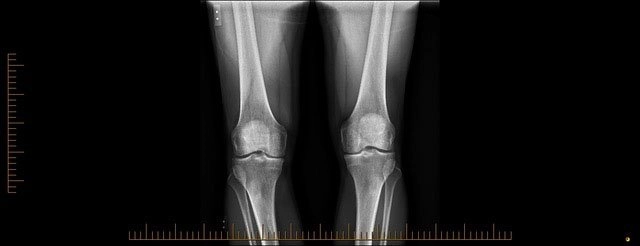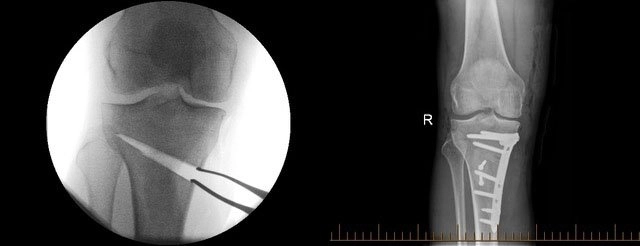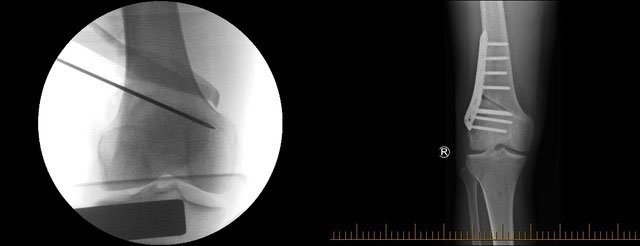
X-ray taken before osteotomy


Intra-operative view and X-ray after high tibial osteotomy


Intra-operative view and X-ray after distal femoral osteotomy
Osteotomy: Before surgery
In most cases, you should continue with any regular prescribed medications in the lead-up to your surgery. I need to know your medical history to plan the best treatment for you in hospital. Particularly, please let me know if you:
- have bleeding disorders or previous problems with blood clots in the legs or lungs
- are taking any blood thinners
- have heart or lung troubles or diabetes
- have had previous joint infections
- are smoking: although smoking is not advisable for your overall health, it is particularly important to cease smoking prior to any surgery as it increases your risk of complications, particularly wound healing and infection
It is a good idea to remain as active as possible. If possible, low-impact activity should be continued leading up to your surgery.
Osteotomy: Day of surgery
You will be admitted on the day of surgery. My team will provide you with the admission time and fasting details.
Osteotomy: Post-operative care
Inpatient stay
Most patients are discharged from hospital after a 1- or 2-night stay. During your hospital stay, the focus will be on keeping you comfortable and commencing the first phases of rehabilitation. You will be seen post-operatively by myself, the physiotherapists and nursing staff who all have a role in your care.
First 2 weeks
The priorities for recovery in the first two weeks after osteotomy are:
- Swelling reduction and management
- Ice, compression and elevation
- Regaining range of motion
- Muscle activity and strengthening
Crutches
In the first two weeks, I suggest you use your crutches to help rest the knee. You can put some lightweight through the knee, but the focus in the first two weeks should be to rest and elevate the knee.
Swelling
Ice your knee as much as possible, for 20 minutes every hour or two with your leg elevated above your body.
Range of motion
You will need to work on range of motion after the surgery. Aim to get your knee nearly flat on the table or bed. Do not sleep or rest with a rolled-up towel or pillow under the knee as this will exacerbate the difficulty. Flexion will return more naturally, but the knee can feel stiff due to swelling and pain.
Follow-up
I will review you in the rooms approximately 2 weeks after surgery. If you are unsure of your follow-up appointment, please call my assistant.
2-6 weeks
This is focused on improving your function and comfort levels:
- reducing the use of crutches
- further improvements in range of motion and swelling
- increased muscle strength
- hydrotherapy and stationary cycling
- re-establishing your normal walking pattern
6 weeks to 3 months +
This period is aimed at increasing the intensity level of your exercise. The timing to return to vigorous exercise may differ between individuals. Remember the focus is on resuming normal activity in a calm, comfortable fashion – balancing pain and swelling with the need to improve movement and activity.
Osteotomy: Wound care
There will be some heavier bandages wrapped around your knee which are generally taken down the day after your surgery. Overlying the surgical incision is an adhesive dressing, which if clean and dry can just be left in place. The nursing staff in hospital will help you with any questions you have regarding your dressings, and I will check the healing of your wound at our follow-up appointment approximately 2 weeks after surgery.
Osteotomy: Pain relief
I use a number of different modalities to help with pain relief, and your anaesthetist will talk you through these. In general, regular paracetamol and an anti-inflammatory (if tolerated) are the mainstays of pain relief. You will be given some stronger medications which can be helpful in the early post-operative period, but these can be phased out as your comfort level increases.
Osteotomy: Driving
The exact time until you return to driving is variable depending on your recovery and the leg you had operated on. It’s sensible to allow at least two weeks to return to driving. For some patients return to driving may be longer.
Osteotomy: Return to work
This will vary depending on the nature of your work. At a minimum, you should have at least 2 weeks away from work to allow the incision to heal and your pain levels to reduce. Office-based workers may plan to return to work at this stage, although those doing heavy manual labour may require 6-12 weeks away from work.
Osteotomy: Physiotherapy
A physiotherapist will visit you twice per day while in hospital, but it is important to perform exercises and activities on your own to enhance your recovery. Once discharged, I recommend you see a physiotherapist regularly until you have recovered to a satisfactory level. I can help you with some advice on appropriate physiotherapists if you do not already have one.
Osteotomy: Problems
Infection
Superficial infection is not very common but can happen. It usually presents as redness and increased pain around the wound, and generally resolves with a short course of antibiotics.
Deep infection
Deep knee infection is rare. If it does happen you will need admission to hospital, with washing out of the incision and high-dose intravenous antibiotics commenced as soon as possible. Symptoms of deep infection include increasing knee pain, swelling, redness and fever.
If you are concerned about an infection, please contact me as soon as possible. During business hours the best point of contact is via my assistant on 08 9212 4292. After hours, please contact the hospital where you had your surgery, and ask them to get in touch with me. Failing this, present to your local Emergency Department for review.
Poor bone healing
Rarely, the bone does not heal as quickly as expected after it has been realigned. Occasionally, revision surgery may be required to stimulate bone healing.
Numbness
It is not uncommon to get some numbness over the front of the knee. This is usually noticed post-operatively, and often gets less noticeable as time progresses. Occasionally it can persist, but is usually very well tolerated.
Foot and ankle swelling
This is normal to an extent, and generally reflects the effects of gravity on the swelling around your knee. If you get excessive foot and ankle swelling, remove your tubi-grip bandage, elevate your leg above your body and ice your knee.
Blood clots
Blood clots can form in the deep veins of the calf or leg, or occasionally these clots can travel to your lungs (pulmonary embolus), affecting your breathing. During your inpatient stay I use blood thinners to help prevent clots from forming, although there is no method that is 100% effective. In the event you do have a large clot in your legs (DVT) or in your lungs, you will need to go on to longer-term blood thinning medication until it has resolved.
Structural damage
This is very rare, but there have been instances of damage to the bones, arteries, nerves and veins in the leg. Some of these require repair during surgery, and other instances will improve with time.
Osteotomy: Costs of treatment
My assistant will provide you with a quote prior to surgery, outlining any costs not covered by Medicare or your health fund.
I am a No Gap Provider for NIB and HBF, and have agreed gaps for other insurers.
If you are considering an osteotomy, please make an appointment to discuss your treatment options.



